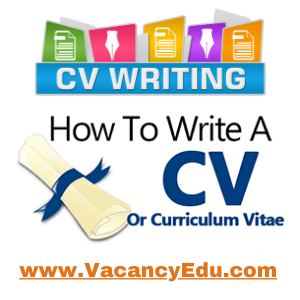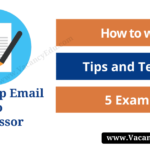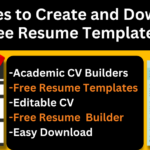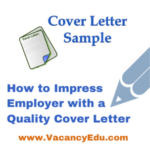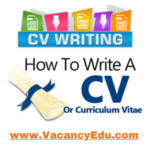How to Write a Curriculum Vitae (CV) for a Job Application
How to write a curriculum vitae: Curriculum Vitaes, or CV’s, are used to apply for teaching or research opportunities, fellowships, further academic training, grants, contract funding proposals, tenure, promotion to professor positions, and membership in a professional society or organization. To get help with your CV, schedule an appointment to see one of our counselors..
Curriculum Vitae (CV) vs. Resumes
| Academia, Faculty | Industry | |
| Main Document for Experiences | CV | Resume |
| Employer Values in the Search | Detail & thoroughness, pedagogy & philosophy, shared decision making | Brevity, practicality, value added, efficiency; limited to 1-2 pages (2 for PhDs or for those with more experience) |
| Key Skills | Research, publishing, teaching | Varies based on position (example skills: analytical, interpersonal, teamwork |
| Additional Documents & Tools | Teaching statement/philosophy, portfolio, LinkedIn | Portfolio, LinkedIn used more widely |
Develop Your CV Strategically
You should have two CVs: a master CV with all information and a tailored CV, which you should write for a specific position or opportunity. In developing your CV, keep the following tips in mind.
You want to make your 3-4 most notable skills, achievements, and knowledge areas leap off the page for readers. This can be done by putting the most related items to the opportunity higher up on your CV. When writing your tailored CV, keep your audience in mind. How technically savvy are they? Will they understand the vocabulary of your field? What are they looking for? What will they find interesting about you?
Material you present early in your CV is likely to stand out more than material placed later. (An exception is that publications are often at the end).
Formatting Your CV
There is no single correct format or style for writing a CV. It is recommended to consult with people in your discipline about particularities of CV’s in your field. You can also see example CV’s and have your CV reviewed by a CAPD counselor.
Typically, CV’s are longer than resumes. Unlike a resume, t is appropriate to describe both teaching and research experience in detail. If applying for a position that primarily involves research, describe research experience first; if the reverse is true, put teaching experience first.
Completeness is more important than brevity. The length is typically 2 to 4 pages for a younger professional, 4 to 7 pages for a person with more experience.
CV Sections and Headings
Headings can be located and titled strategically. Determine what is of primary importance, and put that section first.
- Common CV Headings
- Name & Contact Information
- Education
- Dissertation Title or Topic
- Fellowships/Awards/Honors
- Research Experience
- Teaching Experience
- Other Professional Experience, e.g., Industry Experience, Government Experience
- Presentations
- Publications
Additional CV Headings to Tailor Your CV
- Skills – may include subcategories such as Computer, Languages, Lab Instrumentation
- Professional Associations
- Leadership & Activities – or University Service
- Research Interests
- Areas of Expertise
- Prepared to Teach
- Works in Progress
- Languages
- Dissertation
- Abstract (sometimes included separately)
- References
- Other — could include relevant global / travel experience, professional association memberships, or hobbies and personal interests
Including Work or Professional Experience:
It is acceptable to include work experience if it’s relevant to your academic interests. If you include work experience, it is important to clarify the relevance in your description.
If your work experience is not directly relevant to your academic interests, are there skills you gained that make the experience worth including? Work experience may take a number of forms in your CV. You may describe your experience briefly or list it without description.
Publications Section:
List publications in reverse chronological order.
Put your name in bold to highlight your authorship
Can use asterisk* on papers for which you made leading contribution
Can create separate categories to add clarity: “Publications,” “Presentations”
Can group Publications in sections, e.g: “Books,” “Refereed Articles,” “Abstracts”
Can list “Works in Press,” “Submitted Articles” or “Works in Progress” to show up-and-coming research
Presentations Section:
Papers presented at conferences should include: Title of paper, Name of conference, Dates, Location
Can format conference presentations and publications using the writing style of your field for citations
May indicate sub-headings: “Invited Presentations,” “Posters”
Patents:
A complete list of patents should be included on a CV. If space on a resume is limited, it is permissable to include only the patent number, title, and date under a category header of ‘Issued Patents’.
Example: U.S. Patent 9755095, “Method and structure for multicell devices without physical isolation,” Mar 14, 2014
If the number of patents is large and you have a moderate amount of space on a resume, you can include a selection of patents (see the example below which also includes the inventors). If you have sufficient space you can include all patents.
Issues US patents (3 of 9) US Patent 7482171, “Angiotensin converting enzyme homolog and uses therefore,” Feb 16, 2005 Inventors: Acton, Susan (Lexington, MA), Robison, Keith E. (Wilmington, MA), Hsieh, Frank Y. (Lexington, MA)
US Patent 7268218, “Cardiovascular system associated protein kinase 3 (CSAPK-3) antibodies,” Feb 25, 2004 Inventor: Acton, Susan (Lexington, MA)
If a patent is pending, it may be included but must be designated as pending either under a separate category or within a ‘Patents and Patent Applications’ category and then designated as such(e.g. “US Patent Application 4564848…)
Credit: MIT Career Advising & Professional Development
Related Posts
- Polite Follow-Up Email to Professor : When and How You should Write

- Online PhD Programs: Pros and Cons, Universities, Courses, Career.

- Top Websites to Create and Download Free Resume Templates

- Top 25 Free Statistical Analysis Software 2024

- What is a letter of intent (LOI)? Meaning with Sample

- PhD in Psychology : Career, Admission Process, Benefits, Opportunities.

- What is PhD : Meaning, How to Do, Benefits, Full Details

- How to Write a Motivation Letter for PhD, Postdoc, or Any Position: Sample Motivation Letter

- How to increase Brain Power – Secrets of Brain Unlocked

- Postdoc Application Cover Letter Template

- How to write a Postdoc Job Application or Email

- How to Write a Curriculum Vitae (CV) for a Job Application

- Five Steps of Writing a Great Resume

- How to Write an Effective Cover Letter


